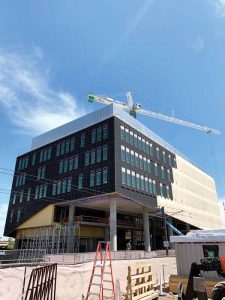
By Brendan Van Gool
The primary function of a wall system is to act as an environment separator. For the last 50 years, the components and design of cavity wall systems have undergone a significant transformation in North America. Higher energy efficiency, more stringent fire safety requirements, sustainability, durability, and better overall performance are driving design changes, and consequently, a shift in requirements to satisfy codes and standards.
At the same time, there is also increasing demand from architects for greater flexibility in design to satisfy aesthetic goals. This affects what happens within the exterior wall construction, as well as on the visible exterior.
Sealed-joint cladding systems are no longer the de facto standard. In such systems, the joints are intentionally sealed to limit the potential for water intrusion. However, since walls will always get wet—whether it is through broken pipes, cracks, or moisture from air leakage—the limited airflow behind the cladding can also contribute to numerous issues, including mold growth and corrosion of materials. By contract, rainscreen systems, such as open-joint and ventilated systems, are increasingly popular in North America. While the gaps may allow water to get behind the cladding, the increased airflow improves the assembly’s drying ability. These systems also have the added benefit of giving architects the design flexibility they seek—varying textures and depth that come with selecting different materials and assemblies.
Insulating in open-joint systems
The building envelope in open-joint systems still needs to serve its primary function, which is control of heat, air, and moisture. One key to a successfully constructed open-joint system is the selection of insulation material, and builders increasingly recognize the many benefits that come from the use of stone wool.

Todd Kimmel, chair of Rainscreen Association in North America (RAiNA) and board member of New York Passive House, says semi-rigid stone wool insulation boards are an ideal option for continuous insulation (ci) on a building’s exterior.
“Codes are asking for increasing amounts of ci to meet the R-value and U-value requirements of ASHRAE 90.1; and there are new test standards under consideration, for example, to evaluate ventilation and drainage potential of products in rainscreen systems where ci is used.”
According to Kimmel, stone wool insulation boards will deliver on these performance requirements, including thermal comfort, energy efficiency, fire protection, water repellency, and sound insulation, even when exposed to the elements. However, in an open-joint system, it is also important for the material to not detract from the aesthetic of the design.




